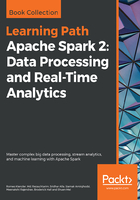
Using the evaluator to assess the quality of the cross-validated and tuned model
Now that we've optimized our Pipeline in a fully automatic fashion, let's see how our best model can be obtained:
var bestPipelineModel = crossValidatorModel.bestModel.asInstanceOf[PipelineModel]
var stages = bestPipelineModel.stages
import org.apache.spark.ml.classification.RandomForestClassificationModel
val rfStage = stages(stages.length-1).asInstanceOf[RandomForestClassificationModel]
rfStage.getNumTrees
rfStage.getFeatureSubsetStrategy
rfStage.getImpurity
rfStage.getMaxBins
rfStage.getMaxDepth
The crossValidatorModel.bestModel code basically returns the best Pipeline. Now we use bestPipelineModel.stages to obtain the individual stages and obtain the tuned RandomForestClassificationModel using stages(stages.length-1).asInstanceOf[RandomForestClassificationModel]. Note that stages.length-1 addresses the last stage in the Pipeline, which is our RandomForestClassifier.
So now, we can basically run evaluator using the best model and see how it performs:

You might have noticed that 0.5362224872557545 is less than 0.5424418446501833, as we've obtained before. So why is this the case? Actually, this time we used cross-validation, which means that the model is less likely to over fit and therefore the score is a bit lower.
So let's take a look at the parameters of the best model:

Note that we've limited the hyperparameter space, so numTrees, maxBins, and maxDepth have been limited to five, and bigger trees will most likely perform better. So feel free to play around with this code and add features, and also use a bigger hyperparameter space, say, bigger trees.